Is Dyslexia the Same as Autism? Differences, Signs & Treatment
Unmasking the differences between dyslexia and autism: signs, treatment, and more. Find clarity on this intriguing topic.
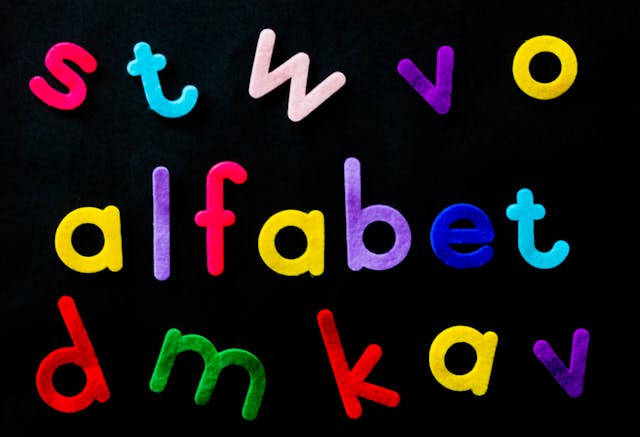
Understanding Dyslexia and Autism
Dyslexia and autism are two distinct neurodevelopmental conditions that can affect individuals in different ways. It's important to understand the characteristics and differences between dyslexia and autism to provide appropriate support and treatment.
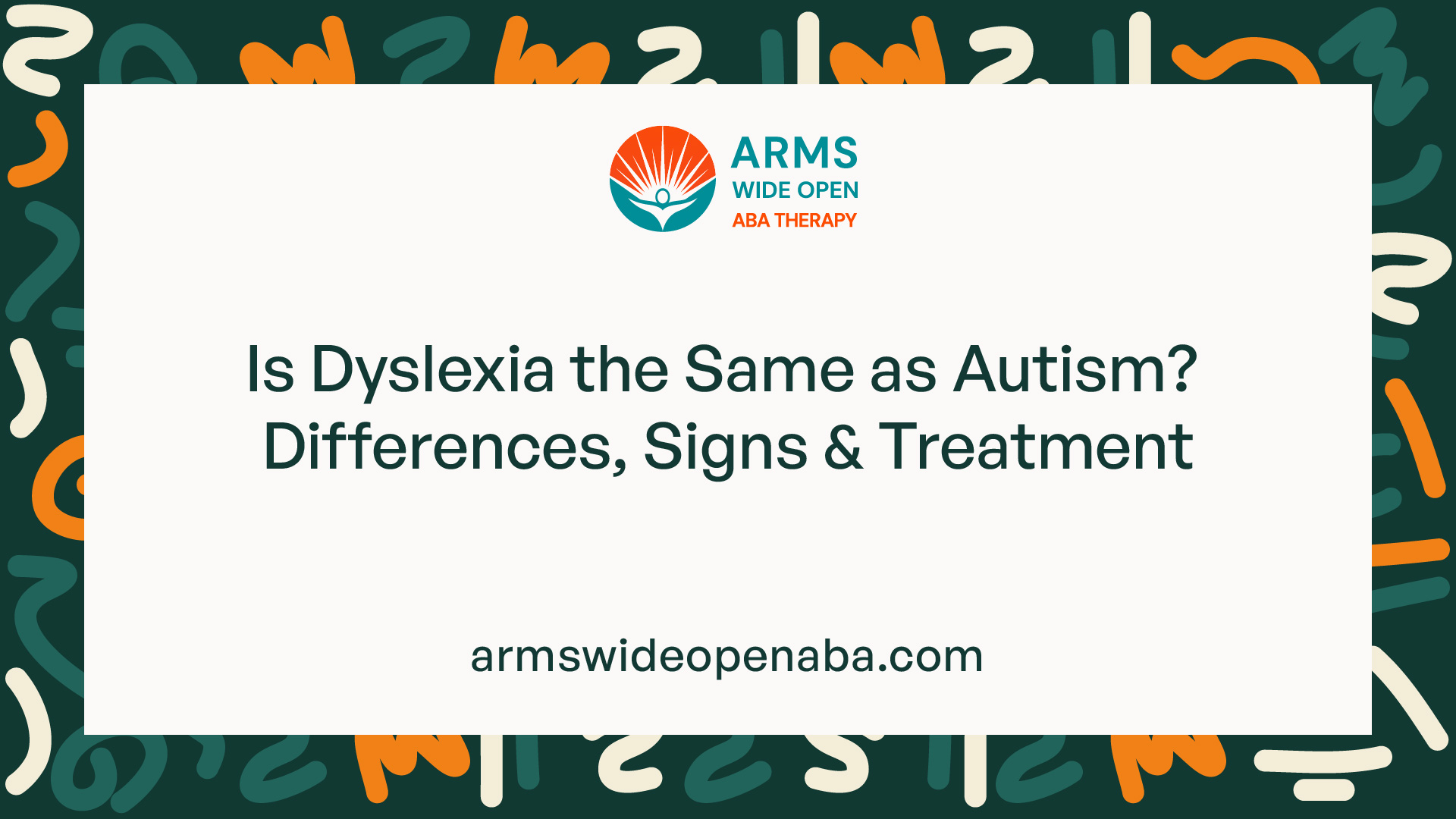
What is Dyslexia?
Dyslexia is a specific learning disorder that primarily affects reading and language skills. Individuals with dyslexia may have difficulty with accurate and fluent word recognition, spelling, and decoding abilities. It is important to note that dyslexia is not related to intelligence or lack of motivation.
What is Autism?
Autism, also known as Autism Spectrum Disorder (ASD), is a complex developmental condition that affects social interaction, communication, and behavior. Individuals with autism may have challenges with social skills, repetitive behaviors, and sensory sensitivities. Autism is a spectrum disorder, meaning that the severity and characteristics can vary greatly among individuals.
Key Differences between Dyslexia and Autism
While dyslexia and autism can share some similarities, they are distinct conditions with different primary areas of difficulty. Here are some key differences between dyslexia and autism:
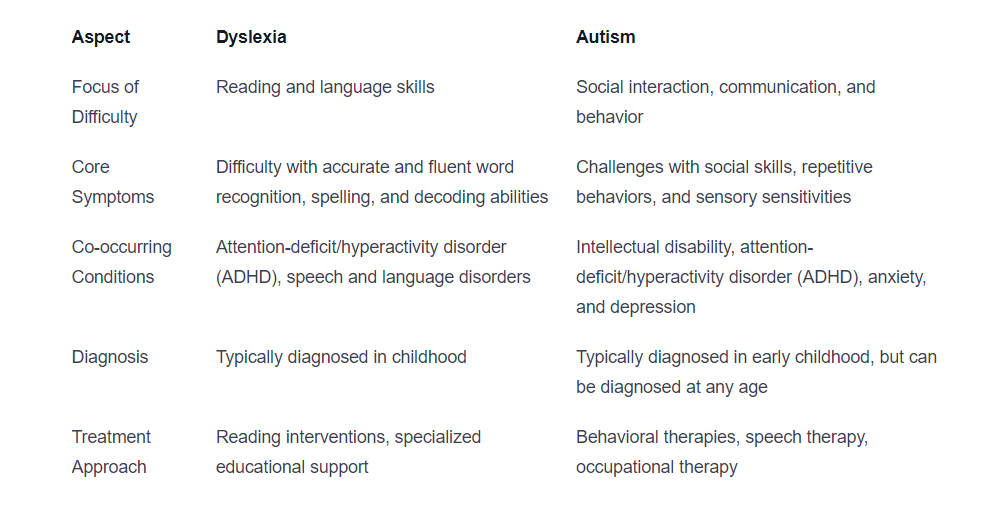
By understanding the differences between dyslexia and autism, individuals, parents, educators, and healthcare professionals can better identify the specific needs and provide appropriate support and interventions. Early identification and intervention play a crucial role in helping individuals with dyslexia or autism reach their full potential and lead fulfilling lives.
Signs and Symptoms
Understanding the signs and symptoms of dyslexia and autism is essential in distinguishing between these two conditions. While they may share some similarities, they also have distinct characteristics that set them apart. Let's explore the signs and symptoms associated with dyslexia and autism.
Dyslexia Signs and Symptoms
Dyslexia primarily affects a person's reading and language processing abilities. Some common signs and symptoms of dyslexia include:
Signs and Symptoms of Dyslexia
Difficulty in reading, including problems with decoding words and recognizing sight words
Slow and laborious reading
Poor spelling and difficulty with written expression
Challenges in understanding and remembering what was read
Trouble following instructions
Difficulty with phonological awareness, such as identifying and manipulating sounds in words
Problems with word retrieval and verbal expression
Struggles with organization and time management
It's important to note that dyslexia can vary in severity, and individuals may exhibit different combinations of these symptoms. Early identification and intervention are crucial for providing appropriate support to individuals with dyslexia.
Autism Signs and Symptoms
Autism, on the other hand, is a neurodevelopmental disorder that affects social interaction, communication, and behavior. The signs and symptoms of autism can vary widely from person to person, but some common indicators include:
Signs and Symptoms of Autism
Challenges in social interaction, such as difficulty with eye contact and understanding social cues
Delayed or limited speech and language development
Repetitive behaviors or restricted interests, such as repetitive movements or intense focus on specific topics
Sensory sensitivities, including hypersensitivity or hyposensitivity to sensory stimuli
Difficulty with transitions and changes in routines
Problems with joint attention and shared interests
Struggles with understanding and expressing emotions
Lack of imaginative play or difficulty with pretend play
Autism is a spectrum disorder, which means that individuals can exhibit a wide range of symptoms and abilities. Early diagnosis and intervention can significantly improve outcomes for individuals with autism.
By recognizing the unique signs and symptoms associated with dyslexia and autism, it becomes evident that these are distinct conditions with their own specific characteristics. Proper assessment and evaluation by qualified professionals are necessary to accurately diagnose and differentiate between dyslexia and autism. This enables individuals to receive appropriate interventions and support tailored to their specific needs.
Diagnosis and Assessment
Accurate diagnosis and assessment are essential for understanding and addressing the unique challenges faced by individuals with dyslexia and autism. In this section, we will explore the diagnostic process for both conditions.
Dyslexia Diagnosis and Assessment
Diagnosing dyslexia involves a comprehensive evaluation conducted by a qualified professional, such as a psychologist or educational specialist. The assessment typically includes the following components:
- Medical and Developmental History: Gathering information about the individual's medical history, developmental milestones, and family history of learning difficulties.
- Cognitive and Academic Assessments: Administering tests to assess cognitive abilities, such as intelligence, memory, and language skills. Additionally, evaluating reading and writing abilities to identify specific reading difficulties.
- Observation and Behavioral Assessments: Observing the individual's behavior, attention, and social interactions to identify any associated difficulties or challenges.
- Screening for Co-occurring Conditions: Assessing for the presence of other conditions that commonly co-occur with dyslexia, such as attention-deficit/hyperactivity disorder (ADHD) or language disorders.
It's important to note that dyslexia is a specific learning disorder and does not require medical testing or imaging studies for diagnosis. The diagnosis is primarily based on the assessment of reading and writing difficulties.
Autism Diagnosis and Assessment
Diagnosing autism involves a comprehensive evaluation conducted by a team of professionals, including psychologists, pediatricians, and speech-language pathologists. The assessment process typically includes:
- Developmental History: Gathering information about the individual's developmental milestones, social interactions, and communication skills from early childhood to present.
- Observation and Behavioral Assessments: Assessing the individual's social interactions, communication abilities, and repetitive behaviors through structured observations and standardized assessments.
- Screening Tools: Utilizing screening tools, such as the Autism Diagnostic Observation Schedule (ADOS) and the Autism Diagnostic Interview-Revised (ADI-R), to gather information from the individual and their caregivers.
- Medical Evaluation: Conducting a medical evaluation to rule out any underlying medical conditions that may contribute to the symptoms.
The diagnostic process for autism focuses on identifying impairments in social communication and the presence of restricted and repetitive behaviors. The evaluation is comprehensive and aims to capture the individual's strengths and challenges across various domains.
It's important to remember that both dyslexia and autism are complex conditions that require thorough assessments by qualified professionals. The diagnosis and assessment process plays a crucial role in developing appropriate intervention strategies and support plans tailored to the individual's specific needs.
Treatment Approaches
When it comes to treating dyslexia and autism, it's important to note that these two conditions require different approaches due to their distinct characteristics. Let's explore the treatment approaches for dyslexia and autism separately.
Dyslexia Treatment Approaches
Treating dyslexia involves a multifaceted approach that aims to address the specific challenges individuals with dyslexia face in reading, writing, and language processing. The following table provides an overview of common dyslexia treatment approaches:
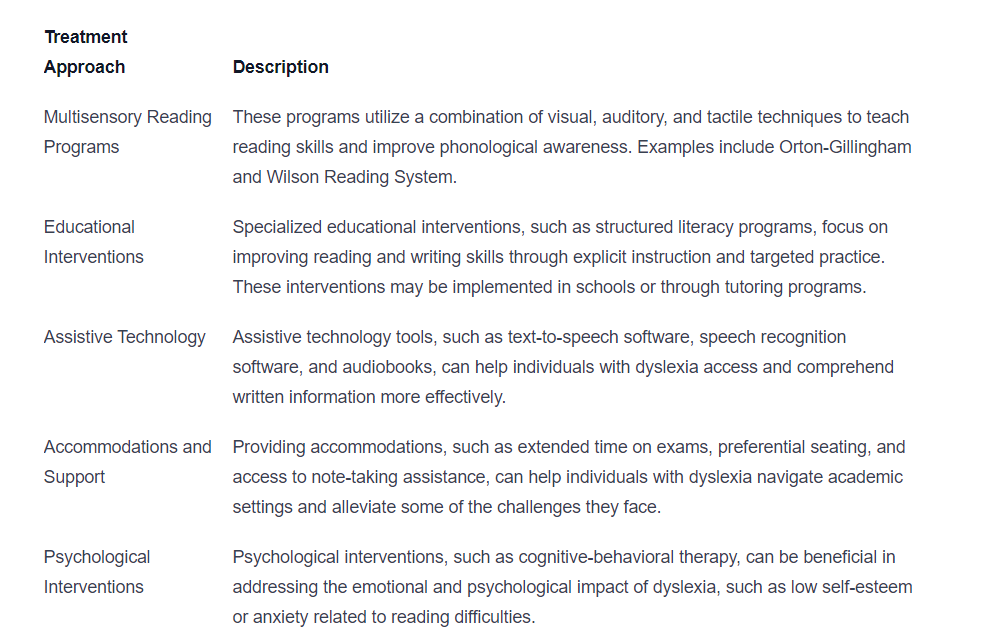
Autism Treatment Approaches
The treatment approaches for autism spectrum disorder (ASD) focus on improving social communication skills, managing behavioral challenges, and addressing the unique needs of individuals with autism. The following table outlines some common treatment approaches for autism:
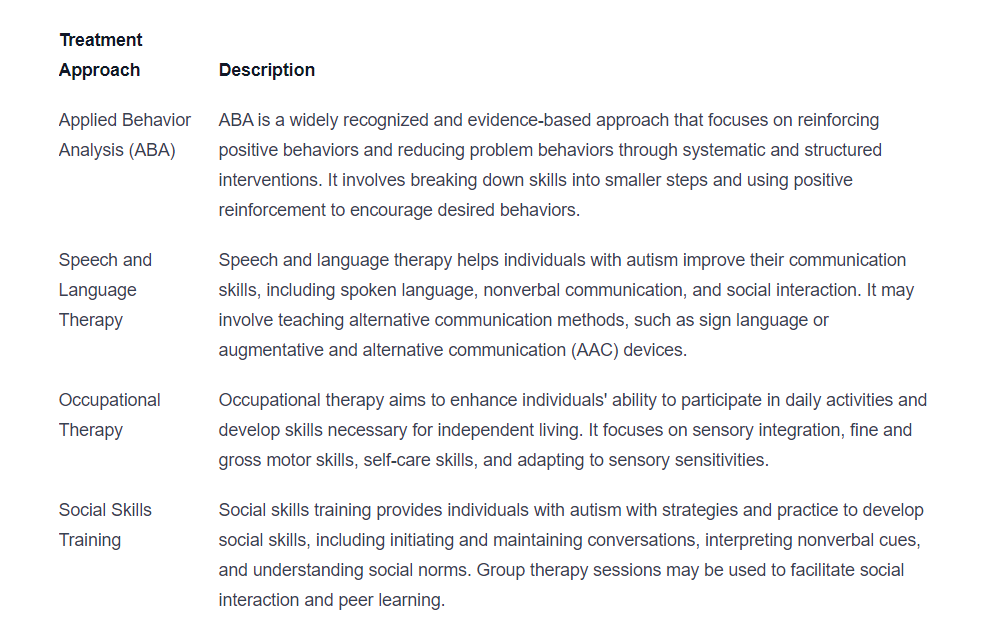
It's important to note that treatment plans for both dyslexia and autism should be individualized based on the specific needs and strengths of each person. A comprehensive and collaborative approach involving educators, therapists, healthcare professionals, and families can help maximize the effectiveness of treatment and support individuals in reaching their full potential.
Support and Resources
When it comes to dyslexia and autism, having access to support and resources is crucial for individuals and their families. Understanding the unique challenges and finding appropriate assistance can make a significant difference in managing these conditions. In this section, we will explore the support and resources available for dyslexia and autism.
Dyslexia Support and Resources
For individuals with dyslexia, various support systems and resources are available to help them thrive academically, emotionally, and socially. Some of the key support options include:
- Special Education Programs: Many schools provide specialized education programs that cater to the specific needs of students with dyslexia. These programs offer targeted interventions and strategies to help improve reading, writing, and comprehension skills.
- Educational Accommodations: Students with dyslexia may be eligible for accommodations in the classroom, such as extra time for exams, the use of assistive technology, or alternative assessment formats. These accommodations aim to level the playing field and ensure equal opportunities for learning.
- Tutoring and Remediation: Dyslexia-focused tutoring and remediation programs can provide additional support outside of the school setting. These programs are designed to address specific difficulties associated with dyslexia and help individuals develop effective reading and writing skills.
- Supportive Organizations: Numerous organizations offer resources, guidance, and advocacy for individuals with dyslexia and their families. These organizations often provide access to information, workshops, support groups, and community networks.
Autism Support and Resources
Support and resources for individuals with autism are essential to help them navigate various aspects of life and reach their full potential. Here are some key avenues for support:
- Early Intervention Services: Early intervention programs play a crucial role in identifying and addressing the needs of children with autism at an early age. These services focus on improving communication, social skills, and behavior management.
- Behavioral Therapy: Applied Behavior Analysis (ABA) is a widely recognized therapy approach for individuals with autism. ABA therapy aims to reinforce positive behaviors and reduce challenging behaviors through individualized strategies and interventions.
- Speech and Language Therapy: Many individuals with autism experience difficulties with communication. Speech and language therapy can help improve language skills, social interaction, and overall communication abilities.
- Supportive Organizations: There are several organizations dedicated to supporting individuals with autism and their families. These organizations offer resources, education, advocacy, and community networks to ensure individuals receive the necessary support and understanding.
It's important to note that the availability and accessibility of support and resources may vary based on geographic location and individual circumstances. Consulting with healthcare professionals, educators, and specialists can help individuals and families navigate the available options and find the most suitable support for dyslexia and autism.
Sources
https://www.medicinenet.com/is_dyslexia_the_same_as_autism/article.htm
https://www.autismparentingmagazine.com/dyslexia-autism/
https://www.ncbi.nlm.nih.gov/pmc/articles/PMC4107832/
Similar articles
We’re here to help you

Our team is here to assist you in this process. Contact us for any assistance.
it’s easy to apply
We Accept Most Insurances
Our in-network insurance partnerships make ABA therapy more accessible to families throughout our service areas.







Our Insurance Process
We'll request your insurance details to help us verify your plan's coverage for ABA therapy. Once we've received this information, we'll walk you through your benefits, including copayments, deductibles and out-of-pocket maximums, so you know what to expect in advance.
Our team will then handle the preauthorization and all the necessary paperwork.
.svg)





















.jpeg)


































.jpeg)




.jpeg)







.jpeg)











.jpeg)
















